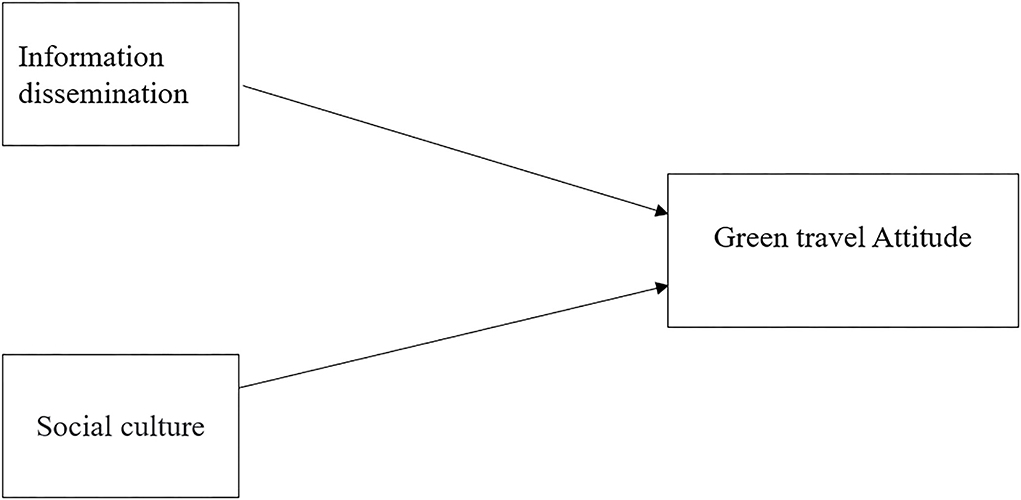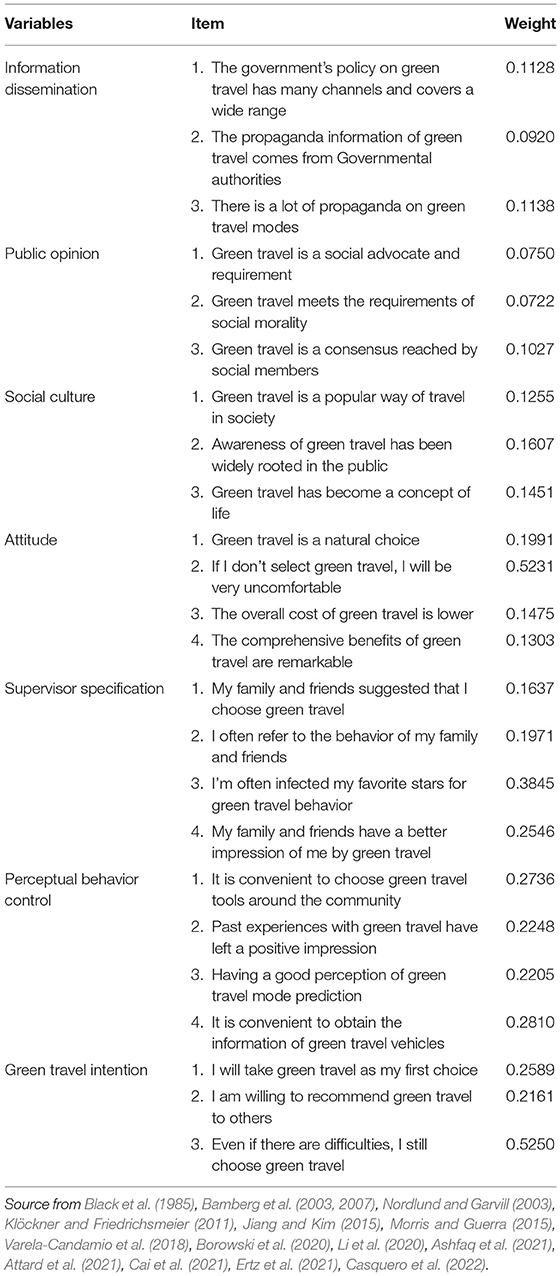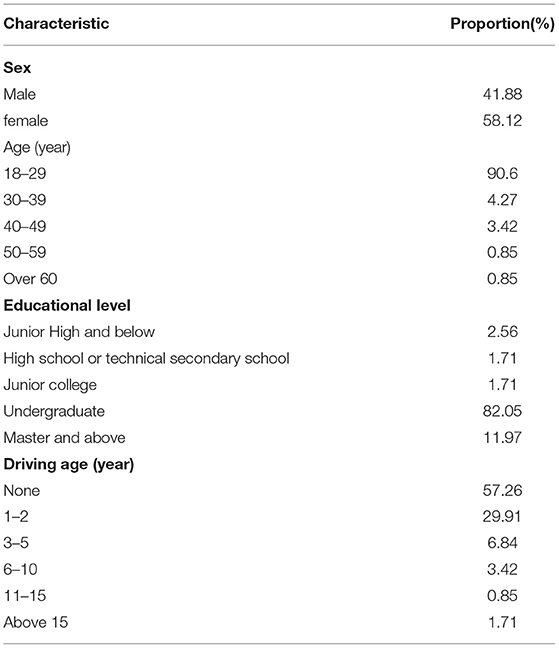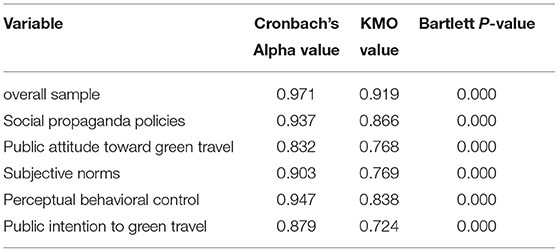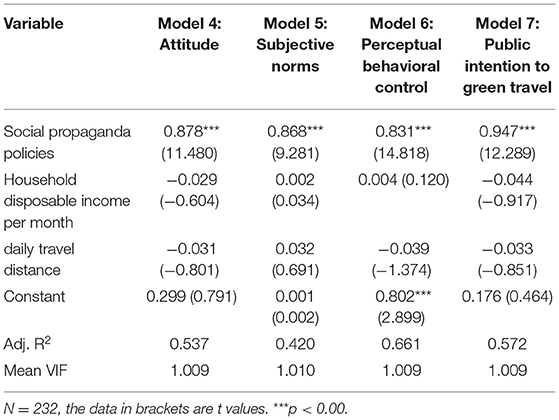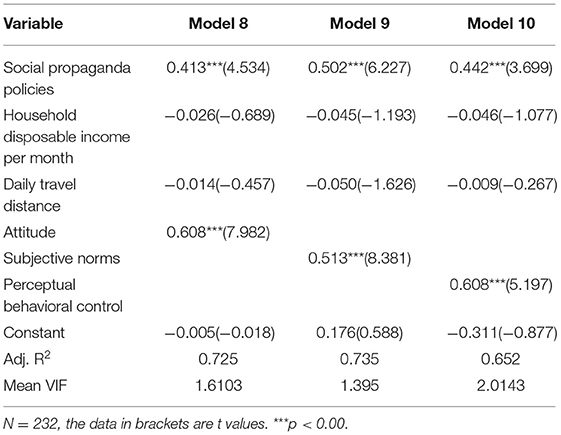Research on the Impact of Social Propaganda and Guidance Policies on Public Green Travel Intention: Evidence From China
- 1School of Economics and Management, Beijing Institute of Petrochemical Technology, Beijing, China
- 2Enterprise Development Research Center, Beijing Institute of Petrochemical Technology, Beijing, China
- 3School of Economics and Management, University of Science and Technology Beijing, Beijing, China
Social propaganda and guidance policies have important practical significance for promoting public green travel. In recent years, the rapid development of digital technology, network, and mobile communication technology has promoted a revolutionary change in the dissemination of information and services. However, in the era of new media communication driven by emerging technologies, there is still a lack of research on the impact of social propaganda and guidance policies on public willingness to travel green. Based on the theory of planned behavior and the survey research of China's urban residents, this study investigates the impact of social propaganda and guidance policies on public willingness to travel green. Regression analysis is used to identify the influencing factors of public green travel willingness, and to reveal the internal impact mechanism of social propaganda and guidance policies on public green travel willingness. The mediating role of public green travel attitude, subjective norm, and perceived behavior control in social propaganda and guidance policy and travel willingness are also empirically analyzed. The results show that social propaganda and guidance policies have a significant positive impact on green travel attitudes, subjective norms, perceived behavior control, and green travel intentions. Green travel attitude, subjective norm, and perceived behavior control play a mediating role in the relationship between social propaganda and guiding policies and green travel willingness, but the mediating effect of the subjective norm is relatively weak.
Introduction
Carbon emissions from the transportation sector have become one of the main areas of carbon emissions in China. In 2020, carbon emissions from the transportation sector accounted for about 10.4% of the total carbon emissions in China, and the average annual growth rate is more than 5%. In particular, carbon emission from road transportation accounts for more than 85% of the total carbon emission in China's transportation (Ministry of Ecology Environment of China, 2021). Therefore, how to enhance public awareness of green travel and promoting public participation in green and low-carbon travel is an important development direction to promote the transition of the transportation industry to sustainability. In recent years, with the rapid development of network information technology and the popularization of smartphones, a variety of emerging publicity media have been provided to promote public green travel, such as Weibo, WeChat mini-programs, low-carbon life service apps, green travel platforms, live broadcast platforms, short videos (e.g., TikTok, Kwai), etc. (Jia, 2018; Wang et al., 2019b; Douglas and Brauer, 2021; Kazhamiakin et al., 2021). However, although scholars have studied the impact of emerging technologies on public green travel from multiple perspectives and levels, in the context of the new media era, the research on the impact of social propaganda and guidance policies on public green travel willingness is still unclear.
There are abundant research results on individual green travel behavior. Among them, the theory of planned behavior (TPB) is one of the most widely used theories(Varela-Candamio et al., 2018; Ashfaq et al., 2021; Casquero et al., 2022). Most studies argued that individuals' attitudes, subjective norms, and perceived behavioral control have a positive impact on green travel behavior (Bamberg et al., 2003; Donald et al., 2014). Attitudes can be divided into cognitive attitudes and affective attitudes, with significant differences in their impact on green travel behavior. Compared with cognitive attitudes, affective attitudes have a more significant impact on the choice of green travel behavior (Black et al., 1985; Bamberg et al., 2007; Morris and Guerra, 2015). Moreover, affective attitudes can be further divided into positive and negative ones (Jang et al., 2009). Considering that only positive affective attitudes have a significant impact on an individual's behavioral motivations and intentions (Jang et al., 2009), social propaganda and guidance policies can improve the positive emotions and attitudes of the public to participate in specific behaviors through education and cultivation (Sultana, 2004) to better promote the public's green and low-carbon travel behavior.
As for the relationship between subjective norms and green travel, studies have shown that social norms will directly or indirectly affect individual green travel behaviors (Kollmuss and Agyeman, 2002; Klöckner and Friedrichsmeier, 2011; Li et al., 2020) and the improvement of personal norms will also help increase the willingness to participate in green travel behavior (Nordlund and Garvill, 2003; Howell, 2014). Although social norms and personal norms have different impacts on public green travel behavior, they can promote each other and jointly determine behavioral intentions (Donald et al., 2014; Ashfaq et al., 2021).
Social propaganda and education are effective methods to promote green travel. Many scholars take social propaganda and education as situational factors to study the impact on green travel. The results showed that social propaganda and education can improve individuals' environmental willingness and self-perceived effectiveness lifestyle (Curtis et al., 1984; Howell, 2014; Milovantseva, 2016; Yang et al., 2018; Borowski et al., 2020). In the process of social propaganda, information dissemination and guidance content play a significant role in promoting green travel behavior (Curtis et al., 1984; Howell, 2014). However, the influence of publicity information on the choice of travel modes of different motivational groups is both consistent and different. The public's travel behavior is not only the individual economic behavior but also group social behavior. They will adjust behavior according to the expectations of society and their intention (Geng et al., 2016; Jia, 2018). Therefore, the government should actively build the social public opinion and social culture toward green travel and guide the public to choose green travel behavior actively (Chen et al., 2014; Howell, 2014; Ju et al., 2019).
The existing literature has a certain basis for the research on the impact of social propaganda and individual planning behavior on public green travel, but there is still room for improvement. First, most of the existing studies simply use social propaganda as a situational factor to discuss its relationship with public green travel and lack in-depth research on the impact process and impact mechanism. In addition, there is a lack of in-depth exploration of mediating variables and mediating effects in the specific research process. Particularly, in the context of the new media era, through the media promoted by these emerging technologies, the environmental protection concept of green and low-carbon travel is promoted to the public to change the public's cognitive value of green travel and increase the willingness of the public to travel green. However, the research on the impact of social propaganda and guidance policies on the public's willingness to travel green is still unclear.
Therefore, this study puts social propaganda, individual planning behavior, and green travel intention into the same research framework. It divides social publicity into three parts: information dissemination, public opinion, and social culture, which is used to analyze the influence process of social propaganda on public green travel and explores the mediating effect of individual planning behavior. It can not only provide a new interpretation logic for studying the influence process of social publicity on individual planning behavior, but also help to reveal the process and internal influence mechanism of social publicity on public green travel intention. The research results provide some reference for the government to adjust social propaganda measures to better improve public green travel awareness.
Theoretical Construction and Research Hypothesis
Social Propaganda Policies and Public Green Travel Planning Behavior
The social propaganda policies in this study refer to the government's use of mass media to strengthen the dissemination of the information advocated, guide the public opinion, create a social atmosphere of green travel, and enhance public awareness of green travel (Borowski et al., 2020; Casquero et al., 2022). This study divides the social propaganda policies into three parts: information dissemination, public opinion, and social culture.
Information dissemination mainly refers to the government's use of various media to promote the concept of green travel and enhance the public's understanding of green travel. Public opinion mainly refers to the public's understanding of the requirements of the government and society on green travel through social publicity and forming opinions of the common tendency of the society. Social culture refers to the formation of popular social atmosphere and social trends, which can accelerate the spread of the concept of green travel.
According to the theory of planned behavior, individual behavior is not only affected by individual subjective attitude but also restricted by external social pressure, behavior execution opportunities, and external resource constraints (Ajzen, 1991, 2002; Donald et al., 2014). Therefore, attitude, subject norms, and perceived behavior control are the main factors affecting individual behavior intention, which jointly determine individual behavior (Ajzen, 2002). In the process of individual choice behavior, social propaganda policies have an important influence on individual behavior attitude, subjective norms, and perceived behavior control.
Social Propaganda Policies Affect Public Attitudes Toward Green Travel
Attitude refers to an individual's subjective evaluation of the performance of a particular behavior. According to the theory of planned behavior, such subjective evaluation is based on an individual's perception of the possible different consequences of the performance of a particular behavior (Liu and An, 2022). This expectation of different consequences forms the expectation of results. According to the social exchange theory, the result expectation can regulate individual behavior. An individual's attitude toward a specific behavior can be obtained by a comprehensive comparison of the benefits and costs brought by the implementation of such behavior (Cropanzano and Mitchell, 2005; Jiang and Kim, 2015; Wang et al., 2019a). Individuals will give a positive evaluation when the comprehensive benefit obtained by predicting a certain behavior is greater than the comprehensive cost. Specifically, the benefits of green travel are mainly reflected in its benefits (including travel safety and convenience) and social benefits (e.g., low carbon emission and low energy consumption). The costs include its costs (e.g., money and time consumption) and environmental costs (e.g., high carbon emission and high energy consumption) (Nordlund and Garvill, 2003; Klöckner and Friedrichsmeier, 2011; Morris and Guerra, 2015). When the public expects to get more benefits than costs from green travel, it will have a positive evaluation. When society has more propaganda channels for green travel, the coverage of the society will become wider, and the public will have a more comprehensive understanding of the benefits and costs of green travel, thus affecting its attitude toward green travel. At the same time, when green travel becomes a social trend and ethos, public demand for green travel will increase significantly. The government will increase the investment in green travel facilities, equipment, and train numbers; transform the original equipment (e.g., eliminate old vehicles and transform auxiliary facilities); improve public travel convenience and comfort; improve the scale of transportation; and further generate economies of scale and reduce ticket prices, Therefore, the income of public travel will be increased, the cost will be reduced, and the public attitude toward green travel will be effectively improved. The process of social propaganda policies affecting public attitudes toward green travel is shown in Figure 1. Therefore, this study proposes hypothesis H1a:
H1a: Social propaganda policies have a significant positive impact on public attitude toward green travel.
Social Propaganda Policies Affect the Subjective Norms of Public Green Travel
Subjective norm refers to the individual's subjective perception of the expectation of others to perform or not to perform a certain behavior, and it is also the overall perception of the social pressure of whether to obey the wishes of others (Cai et al., 2021). In the society, when an individual makes a behavior choice, they will be influenced by others around them, feel the external pressure, and then choose the behavior expected by others to form convergence.
In the process of social propaganda, the information disseminated will affect the common attitude of the group toward a particular behavior, make the group reach a consensus, and individuals will feel external pressure in the process of performing a certain behavior. Therefore, when the social propaganda policies advocating green travel are widely spread in the society, social groups will form a consensus to actively participate in green travel, and then form the public opinion to actively choose green travel, and the public will feel the social pressure to obey the wishes of others when choosing a travel mode. The process of social propaganda policies affecting public attitudes toward green travel is shown in Figure 2. This study proposes the hypothesis:
H1b: Social propaganda policies have a significant positive impact on public subjective norms of green travel.
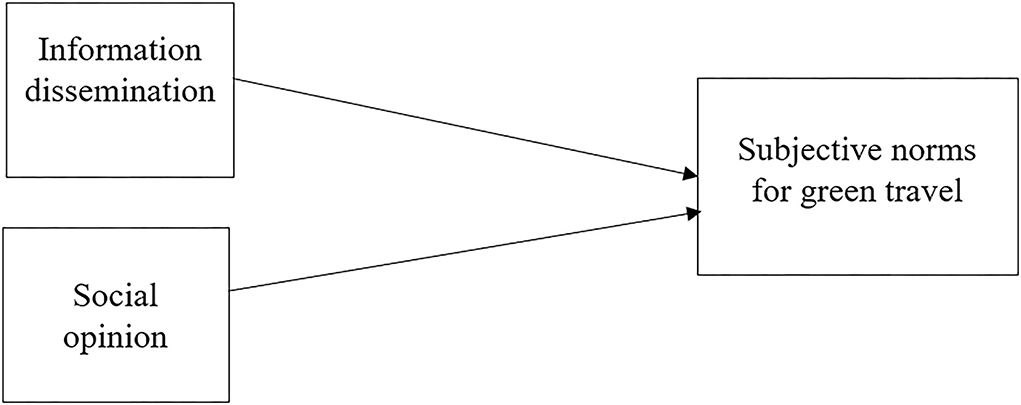
Figure 2. Influence process of social propaganda policies on public subjective norms of green travel.
Social Propaganda Policies Affect the Perceptual Behavioral Control of Individual Green Travel
Perceptual behavioral control refers to an individual's assessment and perception of the ability to perform a specific behavior (Ajzen, 2002; Donald et al., 2014). It includes internal control factors and external control factors, that is, whether an individual has the confidence and external objective conditions to complete a certain behavior (Dastjerdi et al., 2019; Tirachini et al., 2020; Ashfaq et al., 2021). When an individual performs a particular behavior, he or she will make a comprehensive comparison based on personal experience accumulation and expected obstacles to judge the difficulty of performing a particular behavior. Specifically, when the traffic information publicized by the society is more comprehensive and the public gets more information about public transport, such as the accurate departure time and estimated arrival time of buses and subways, bus stations, subways, stations, and vehicle distribution points sharing bicycles, real-time congestion on roads and other information, which will improve the good prediction of public green travel modes. At the same time, when green travel forms a social atmosphere and social trend, the government will increase the number and operation frequency of green travel tools to meet the increasing demand for riding, promote the elimination of old equipment, and improve the comfort and convenience of riding and use. Figure 3 shows the process of social propaganda policies affecting public attitudes toward green travel. Therefore, this study proposes the hypothesis:
H1c: Social propaganda policies have a significant positive influence on public perceived behavior control of green travel.
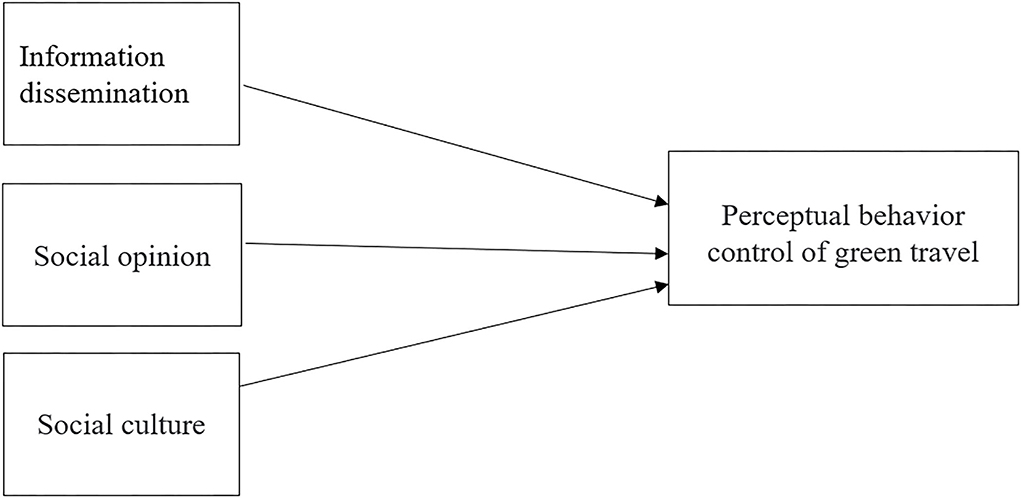
Figure 3. Influence process of social propaganda policies on public perceived behavior control of green travel.
Social Propaganda Policy and Green Travel Intention
According to the theory of persuasion, when the information received by an individual comes from an authority or appears frequently, the subjective construction of individuals will be affected and the subjective impression of a particular thing will be changed (Cropanzano and Mitchell, 2005; Jiang and Kim, 2015). And when a certain phenomenon forms social culture in society, individuals will be influenced by social public opinion and thus consciously abandon or choose certain behaviors. Therefore, when the government publicizes green travel policy to the public through various forms of new media and advertisements, advocates green travel, and forms a social culture of green travel, the public will change its cognitive structure of green travel to a certain extent, thus changing its intention of green travel. Therefore, the following hypothesis is proposed in this study:
H2: Social propaganda policies have a significant impact on public intention toward green travel.
Mediating Effects of Public Green Travel Planning Behavior
Mediating Effect of Public Attitude
Public attitudes toward green travel depend on the result expectation formed by comparing the comprehensive benefits and costs of this behavior. When the government comprehensively publicizes the green travel information through various new media means, the public can deeply understand the carbon emissions per kilometer and energy consumption (e.g., gasoline, diesel, and electricity) of public transport (e.g., bus and subway) and passenger cars, the distribution of bus stations, subway stations, and shared bicycle equipment as well as the real-time traffic congestion and the estimated travel time. So it can accurately evaluate the benefits and costs of green travel. When it is predicted that the comprehensive income obtained by choosing green travel is greater than the comprehensive cost, it will give a positive evaluation on green travel. When attitudes change, the actions will be with the change. Therefore, this study puts forward the following assumption:
H2a: Public green travel attitude plays an intermediary effect between social propaganda policies and intention of green travel.
Mediating Effects of Subjective Norms
Based on the perspective of social networks, individuals are embedded in complex social networks, forming a complex and diverse network between individuals and others. Individuals will be under pressure from network members when choosing a specific behavior. This pressure will be affected by the network structure of the individual (Liu and An, 2022). Family members, close friends, and colleagues must be in the network. They will reach some tacit understanding in the process of interaction, which will affect the behavior choice of all individuals (Xiao and Dang, 2018). Generally, members will choose the behavior expected by other network members to alleviate the pressure caused by individual differences. Specifically, the social propaganda advocating green travel forms a consensus and generates social public opinion among social groups. Public is bound to be influenced by its family and friends when choosing travel modes, and will choose green travel modes it excepts to alleviate the pressure caused by differences in travel modes. Therefore, this study puts forward the following assumption:
H2b: Public subjective norms of green travel play an intermediary effect between social propaganda policies and green travel intention.
Mediating Effects of Perceived Behavior Control
Perceptual behavior control mainly reflects the obstacles to the implementation of a certain behavior based on experience and psychological expectations. The more resources and opportunities an individual has, the more perceptual control of behavior will be (Ajzen, 2002). For the choice of green travel behavior, the public mainly perceives it based on the convenience and time cost of green transportation. When the public knows the advantages of adopting green travel based on comprehensive propaganda information, it will have good psychological expectations and will be more willing to choose green travel. Therefore, this study puts forward the assumption:
H2c: Public perceived behavior control of green travel plays an intermediary role in social propaganda and guidance policies and green travel intention.
Theoretical Model
Based on the theory of planned behavior and social exchange, taking “social propaganda—individual planning behavior—individual behavior intention” as the logical thread, this study constructs a theoretical model of the impact of social propaganda policy on public green travel intention, as shown in Figure 4.
Research Design
Research Methods
The Construction of the Index
First, the weight of each index is determined. Considering that the subjective weighting method leads to biased results due to the limitation of human experience, this study uses the entropy method in the objective weighting method for weighting. The specific evaluation steps are as follows (Zhao et al., 2018; Bonakdari et al., 2020):
First, calculate the proportion of the measurement item i in the index j.
Second, calculate the entropy of index j.
Where,k = 1/ln n
Third, calculate the weight of each index.
The variables of social propaganda policies, attitude, subjective norms, perceived behavior control, and green travel intention are constructed by the linear weighting method.
Construction of Measurement Model
This study selects family monthly disposable income and daily main travel distance as the control variable.
(1) Household disposable income per month. The family monthly disposable income has a certain impact on the willingness to green travel. The family monthly disposable income affects the ability of families to purchase cars and determines the sensitivity and requirements of family members for travel costs. In general, for families with higher disposable income, family members are not sensitive to travel costs, but have higher requirements for travel time, comfort, and convenience. Therefore, the monthly disposable income of households affects public green travel intention.
(2) Daily main travel distance. The daily main travel distance refers to the daily travel distance of respondents in their daily life (including travel, shopping, and other activities). The daily main travel distance will determine the choice of transportation for travelers, thus affecting the willingness of green travel. Generally, when the daily main travel distance is within 3 km, travelers tend to choose to walk, bicycle and use buses. When the daily main travel distance is within 4–10 km, travelers prefer buses, taxis, and subways. When the daily main travel distance is >10 km, travelers will choose buses, subways, and private cars. Therefore, the daily main travel distance will affect public willingness to travel green.
To test the impact of social propaganda policy on the attitude, subjective norms, and perceived behavior control, models (4)–(6) are constructed.
Where, at stands for attitude, sn stands for subjective norm, bc stands for perceived behavior control, spp stands for social propaganda policy, hdip stands for household disposable income per month, dtd stands for daily travel distance, β40β50β60 stand for constant terms, and ε stands for random error term.
When β41, β51, β61 in models (4), (5), and (6) are >0 and significant. This shows that the assumptions H1a, H1b, and H1c are supported.
A model is built to test the impact of social propaganda policies on public green travel intention (7).
Among them, gti represents green travel intention, spp stands for social propaganda policy, ε represents random error term, andβ70represents the constant term. When β71, the social propaganda policy coefficient is >0 and significant, it indicates that hypothesis H2 is supported.
This study analyzes the mediating effect of public green travel attitude by referring to the test methods of mediating effect of many existing studies (Baron and Kenny, 1986; Wen et al., 2004; Aguinis et al., 2005; Chawla and Joshi, 2018). Taking public attitude, subjective norms, and perceived behavior control into the model together with social propaganda policies can test their impact on green travel intention. When the coefficient of social propaganda policy β81 and the coefficient of attitude β82 in model (8) are >0 and significant, and the coefficient β81 is smaller than β71 in model (7), it indicates that attitude has an intermediary effect and H2a is supported. When the coefficient of social propaganda policyβ91 and coefficient of subjective normβ92in model (9) are >0 and significant, and β91 is smaller than β71 in model (7), it indicates that subjective norm has an intermediary effect and H2b is supported. The coefficient of social propaganda policy, β101and the coefficient of perceptual behavior control β102 in model (10) are >0 and significant, andβ101is smaller than β71in model (7), which indicates that perceptual behavior control has an intermediary effect, so H2c is supported.
Measurement Items
The measurement of each index is investigated by setting a scale, as shown in Table 1. The scale has 24 items. The scale of social propaganda policy is investigated from three dimensions: information dissemination, social public opinion, and social culture. Three items are set for each dimension to measure. The public green plan behavior scale is divided into three dimensions: attitude, subjective norms, and perceived behavior control. Four items are set in each dimension for the evaluation of the investigators. The public green travel intention is evaluated by setting three items. For each item, the 5-point Likert scale is used for evaluation, and the setting levels are “very agree (5 points)”, “relatively agree (4 points)”, “generally agree (3 points)”, relatively disagree (2 points), and very disagree (1 point). The score of the scale under each dimension is added to the total score. The higher the score on the scale, the greater the degree of the corresponding dimension.
Research Samples
Based on the principle of random sampling, this study randomly selected communities near public bicycles, bus stations, and subway stations in many districts of Beijing to conduct a questionnaire survey. A total of 300 questionnaires were distributed and 285 were recovered, with a recovery rate of 95%. Excluding invalid questionnaires, 232, valid questionnaires were obtained, with an effective rate of 81.4%. The distribution of gender, age, education level, and driving age is shown in Table 2.
Empirical Analysis
Test of Reliability and Validity
Reliability and validity tests were carried out on the overall data and each latent variable, and the results are shown in Table 3. Cronbach's alpha value of the overall data was 0.971, >0.8, indicating that the overall data reached the credibility level. Cronbach's alpha values of latent variables such as social propaganda policies, public green travel attitude, subjective norms, perceived behavior control, and public green travel intention were 0.937, 0.832, 0.903, 0.947, and 0.879, respectively, all >0.8, passing the reliability test and reaching the credibility level.
The KMO values of the overall sample, social propaganda policy, public attitude, subjective norms, perceived behavioral control, and public willingness to green travel were 0.919, 0.866, 0.768, 0.769, 0.838, 0.724, respectively, with p-values of 0.000, thus, the sample data had good validity.
Regression Analysis Results
Basic Regression Analysis Results and Analysis
The weights of each variable were obtained by substituting the data into formulas (1)–(3), as shown in Table 1, and the data of each variable were obtained by linear weighting. SPSS25.0 software was used for regression analysis of models (4)–(7), and the results are shown in Table 4.
The mean VIF of models (4)–(7) were 1.009, 1.010, 1.009, and 1.009, indicating that the multicollinearity effect of the four models was within a reasonable range.
According to the regression results of model 4, the coefficient of social propaganda policies is 0.878, which is significant at a 1% level, indicating that social propaganda policies have a significant positive correlation with public attitude toward green travel. With every unit increase in social publicity and guidance policy, the public attitude toward green travel will increase by 0.878 units. The results show that social propaganda policies show a positive influence on public attitude toward green travel. The wider the publicity scope of green travel and the diversified publicity means, the more positive the subjective attitude of the public toward green travel will be. Therefore, it is assumed that H1a is supported by the test results, that is, social propaganda policies have a significant positive impact on public attitude toward green travel.
According to the regression result of model 5, the coefficient of social propaganda policies is 0.868, and is significant at a 1% level, indicating that social propaganda policies have a significant positive correlation with public subjective norms of green travel and a positive impact on the public subjective norm. The stronger the public opinion formed by the government's publicity of green travel, the greater the influence of others on the public choice of green travel, and subsequently, more positive their psychological obedience to social wishes. Therefore, it is assumed that H1b is supported by the test results, that is, social propaganda policies have a significant positive impact on public subjective norms of green travel.
Regression results of model 6 show that the coefficient of social propaganda policies is 0.831, and is significant at a 1% level, indicating that social propaganda policies have a significant positive correlation with public perceived behavior control of green travel and a positive impact on public perceived behavior control. When the government has richer means of social publicity for green travel and the publicity media can probe into public lives, the public can obtain more comprehensive travel information, which improves the public's good perception of green travel, and the good experience obtained after choosing green travel can stimulate public's enthusiasm to choose green travel, thus affecting perceived behavior control. Therefore, the hypothesis of H1c is supported by the test results, that is, social propaganda policies have a significant positive impact on the public's perceived behavior control of green travel.
The regression results of model 7 show that the coefficient of social propaganda policies is 0.947, and is significant at a 1% level, indicating that social propaganda policies have a significant positive correlation with public green travel intention and a positive impact on public green travel intention. When the government vigorously propagandizes green travel and forms the social culture, it will change the psychological cognitive structure and cognitive value of the public, making it realize the positive role of green travel on society and itself, and improve the willingness for green travel. Therefore, hypothesis H2 is supported by the test results, that is, social propaganda policies have a significant positive impact on public willingness to green travel.
As to the control variables, the monthly disposable income and daily main travel distance of families are negatively correlated with green travel attitude and travel intention, but they are not significant. It shows that with the increase in disposable income and travel distance, public attitude and willingness to green travel show a downward trend. The household monthly disposable income and daily main travel distance are positively correlated with the subjective norms of green travel, but they are not significant. However, the influence on perceptual behavior control shows the opposite trend. There is a positive correlation between monthly disposable income and perceived behavior control, while there is a negative correlation between daily main travel distance.
Regression Results and Analysis of Mediating Effects
Regression tests were conducted on models (8)–(10) to test the mediation effect, and the results are shown in Table 5.
According to the regression results, the average VIF values of models (8)–(10) are 1.6103, 1.395, and 2.0143, respectively, all <10, indicating that there is no multicollinearity problem. The coefficients of social propaganda policies in model 4 and model 7 are significant, indicating that they are in line with the mediation effect test process. For model test results of 8, Adj R2 is 0.725, which is 0.153 higher than that of model 7, and the coefficient of attitude is 0.608, which is significant under the 1% level. Attitude has a significant positive correlation with public green travel intention, indicating that public attitude toward green travel has a positive impact on green travel intention. Meanwhile, the coefficient of social propaganda policies is 0.413, which is significant at the 1% level, but significantly lower than the coefficient in model 7 (Δβ = 0.534). Therefore, the public attitude toward green travel plays an intermediary role in the relationship between social propaganda policies and green travel intention. Hypothesis H2a has been verified and supported.
The mediating effect of public subjective norms was analyzed. The coefficients of social propaganda policies in model 4 and model 7 were significant at a 1% level, indicating that the mediating effect test process was in line with the mediation effect test process. The results of model 9 show that the Adj. R2 is 0.735, 0.163 higher than that of model 7, indicating that the degree of data fitting has been significantly improved. The coefficient of subjective norms is 0.513, which is significant at a 1% level. Subjective norms have a significant positive correlation with public green travel intention. It shows that subjective norms have a positive influence on green travel intention. Each additional unit of the subjective norm will increase green travel intention by 0.513 units. Meanwhile, the coefficient of social propaganda policies is 0.502, which is significant at a 1% level, but significantly lower than the coefficient in model 7 (Δβ = 0.445). Therefore, public subjective norms of green travel play a mediating role in the relationship between social propaganda policies and green travel intention, however, compared with attitude, the mediating effect is weak. Assume that H3b is validated and supported.
The mediating effect of public perceptual behavior control was analyzed. The coefficients of social propaganda policies in model 6 and model 7 are significant at a 1% level, indicating that they conform to the first two stages of the mediation effect testing process. The Adj. R2 is 0.625, 0.053 higher than that of model 7, indicating that the degree of data fitting has been improved to some extent. The coefficient of perceived behavior control is 0.608, which is significant at a 1% level, indicating that perceived behavior control has a significant positive correlation with public green travel intention. The results showed that public perceptual behavioral control had a positive influence on travel intention. Each additional unit of perceived behavioral control will increase green travel intention by 0.608 units. Meanwhile, the coefficient of social propaganda policies is 0.442, which is significant at the 1% level, but significantly lower than the coefficient in model 4 (Δβ = 0.505). Therefore, public perceived behavior control of green travel plays a mediating role in the relationship between social propaganda policies and green travel intention, indicating that H3c is validated and supported.
Among the three models of mediating effect, the monthly disposable income and daily main travel distance of households are not significantly negatively correlated with the willingness to green travel, indicating that when the three mediating variables of attitude, subjective norms, and perceived behavior control are added, the willingness of the public to green travel continues to decline with the increase of monthly disposable income and daily main travel distance of households. In this case, the public has higher requirements for travel comfort and convenience, and less consideration for travel economic cost and environmental cost, which is consistent with the views of Cai et al. (2021).
Conclusions and Implications
Based on the theory of planned behavior and social exchange theory, this study builds a theoretical model of the influence of social propaganda policies on public green travel intention and empirically tests the relationship between social propaganda policies and the public's green travel intention through a questionnaire survey. It reveals the internal influence mechanism of social propaganda policies on the public's green travel intention. The main findings are as follows.
(1) Social propaganda and guidance policies have a significant positive impact on public willingness to travel green. It has a significant positive impact on public attitudes, subjective norms, and perceived behavioral control of green travel.
(2) Public attitudes, subjective norms, and perceived behavioral control of green travel play a mediating effect between social propaganda policies and green travel intention. Among them, the mediating effect of the subjective norm is relatively weak.
(3) The monthly disposable income of the household and the daily main travel distance have a negative correlation with the public green travel willingness, indicating that the public mainly considers its costs when choosing travel modes, and less consideration for environmental costs.
To better improve the public's green travel intention, the government should continue to propagandize the public actively using various new media, such as WeChat, Weibo, live platforms, short videos, etc. At the same time, the government should improve the authority of publicity agencies to help to change the public cognitive value of green travel, and improve public willingness to green travel. In terms of propaganda content, it should change the past propaganda content such as energy consumption and environmental pollution, and add diversified information that is closely related to public daily life, such as emotion, economy, safety, health, and environmental protection. In the video publicity content, advocacy and reminders among family members and friends can be added to encourage the use of public transportation such as buses and subways to form a positive social public opinion. Finally, it should include the time, distribution, riding cost, comfort, the interior environment of public transportation, etc. so that the public can obtain comprehensive information, which can not only allow the public to fully predict the benefits and costs but also improve the expected value of public green travel.
This study also has several limitations that pave the way for future research. First, this study uses cross-sectional data to analyze the impact of social propaganda and guidance policies on public green travel intention. However, individuals' preferences and motivations for green travel behavior will change over time under the influence of the external environment and internal demand. Therefore, it is necessary to expand the time dimension in future research to further explore the dynamic evolution mechanism of the influence of social propaganda and guidance policies on the public's attitude and willingness to green behavior. In addition, the social survey of this study was conducted in Beijing. Due to the limitation of the sample, the research conclusions of this study lack some universality to a certain extent, especially for the cities in central, western, and eastern China. Therefore, the geographic scope and sample size of the social survey will be expanded for further research and verification in the future. In particular, the heterogeneity of different regions should be further explored in depth.
Data Availability Statement
The original contributions presented in the study are included in the article/supplementary material, further inquiries can be directed to the corresponding author/s.
Ethics Statement
Ethics review and approval/written informed consent was not required as per local legislation and institutional requirements.
Author Contributions
DY contributed to the conceptualization, empirical analysis, and first draft of the manuscript. SS helped with research design, data collection, and processing. All authors contributed to the article and approved the submitted version.
Funding
This work was supported by Social Science Foundation of Beijing Municipal Education Commission (General Program) (Grant No. SM202210017001).
Conflict of Interest
The authors declare that the research was conducted in the absence of any commercial or financial relationships that could be construed as a potential conflict of interest.
Publisher's Note
All claims expressed in this article are solely those of the authors and do not necessarily represent those of their affiliated organizations, or those of the publisher, the editors and the reviewers. Any product that may be evaluated in this article, or claim that may be made by its manufacturer, is not guaranteed or endorsed by the publisher.
References
Aguinis, H., Beaty, J. C., Boik, R. J., and Pierce, C. A. (2005). Effect size and power in assessing moderating effects of categorical variables using multiple regression: a 30-year review. J. Appl. Psychol. 90, 94. doi: 10.1037/0021-9010.90.1.94
Ajzen, I (1991). The theory of planned behavior. Organ. Behav. Hum. Decis. Process. 50, 179–211. doi: 10.1016/0749-5978(91)90020-T
Ajzen, I (2002). Perceived behavioral control, self-efficacy, locus of control, and the theory of planned behavior 1. J. Appl. Soc. Psychol. 32, 665–683. doi: 10.1111/j.1559-1816.2002.tb00236.x
Ashfaq, M., Zhang, Q., Ali, F., Waheed, A., and Nawaz, S. (2021). You plant a virtual tree, we'll plant a real tree: Understanding users' adoption of the Ant Forest mobile gaming application from a behavioral reasoning theory perspective. J. Clean. Prod. 310, 127394. doi: 10.1016/j.jclepro.2021.127394
Attard, M., Cañas, C., and Maas, S. (2021). Determinants for walking and cycling to a university campus: insights from a participatory Active Travel workshop in Malta. Transp. Res. procedia 52, 501–508. doi: 10.1016/j.trpro.2021.01.059
Bamberg, S., Ajzen, I., and Schmidt, P. (2003). Choice of travel mode in the theory of planned behavior: the roles of past behavior, habit, and reasoned action. Basic Appl. Soc. Psych. 25, 175–187. doi: 10.1207/S15324834BASP2503_01
Bamberg, S., Hunecke, M., and Blöbaum, A. (2007). Social context, personal norms and the use of public transportation: two field studies. J. Environ. Psychol. 27, 190–203. doi: 10.1016/j.jenvp.2007.04.001
Baron, R. M., and Kenny, D. A. (1986). The moderator–mediator variable distinction in social psychological research: conceptual, strategic, and statistical considerations. J. Pers. Soc. Psychol. 51, 1173. doi: 10.1037/0022-3514.51.6.1173
Black, J. S., Stern, P. C., and Elworth, J. T. (1985). Personal and contextual influences on househould energy adaptations. J. Appl. Psychol. 70, 3. doi: 10.1037/0021-9010.70.1.3
Bonakdari, H., Gholami, A., Mosavi, A., Kazemian-Kale-Kale, A., Ebtehaj, I., Azimi, A. H., et al. (2020). A novel comprehensive evaluation method for estimating the bank profile shape and dimensions of stable channels using the maximum entropy principle. Entropy 22, 1218. doi: 10.3390/e22111218
Borowski, E., Chen, Y., and Mahmassani, H. (2020). Social media effects on sustainable mobility opinion diffusion: Model framework and implications for behavior change. Travel Behav. Soc. 19, 170–183. doi: 10.1016/j.tbs.2020.01.003
Cai, J., Liu, W., and Ma, S. (2021). Residents'green travel behavior and willingness deviation in Xi'an. J. Arid L. Resour. Environ. 35, 31–37. doi: 10.13448/j.cnki.jalre.2021.294
Casquero, D., Monzon, A., García, M., and Martinez, O. (2022). Key elements of mobility apps for improving urban travel patterns: a literature review. Futur. Transp. 2, 1–23. doi: 10.3390/futuretransp2010001
Chawla, D., and Joshi, H. (2018). The moderating effect of demographic variables on mobile banking adoption: An empirical investigation. Glob. Bus. Rev. 19, S90–S113. doi: 10.1177/0972150918757883
Chen, H., Long, R., Niu, W., Feng, Q., and Yang, R. (2014). How does individual low-carbon consumption behavior occur?–An analysis based on attitude process. Appl. Energy 116, 376–386. doi: 10.1016/j.apenergy.2013.11.027
Cropanzano, R., and Mitchell, M. S. (2005). Social exchange theory: an interdisciplinary review. J. Manage. 31, 874–900. doi: 10.1177/0149206305279602
Curtis, F. A., Simpson-Housley, P., and Drever, S. (1984). Communications on energy Household energy conservation. Energy Policy 12, 452–456. doi: 10.1016/0301-4215(84)90109-5
Dastjerdi, A. M., Kaplan, S., e Silva, J. A., Nielsen, O. A., and Pereira, F. C. (2019). Participating in environmental loyalty program with a real-time multimodal travel app: User needs, environmental and privacy motivators. Transp. Res. Part D Transp. Environ. 67, 223–243. doi: 10.1016/j.trd.2018.11.013
Donald, I. J., Cooper, S. R., and Conchie, S. M. (2014). An extended theory of planned behaviour model of the psychological factors affecting commuters' transport mode use. J. Environ. Psychol. 40, 39–48. doi: 10.1016/j.jenvp.2014.03.003
Douglas, B. D., and Brauer, M. (2021). Gamification to prevent climate change: a review of games and apps for sustainability. Curr. Opin. Psychol. 42, 89–94. doi: 10.1016/j.copsyc.2021.04.008
Ertz, M., Favier, R., Robinot, É., and Sun, S. (2021). To waste or not to waste? Empirical study of waste minimization behavior. Waste Manag. 131, 443–452. doi: 10.1016/j.wasman.2021.06.032
Geng, J., Long, R., and Chen, H. (2016). Impact of information intervention on travel mode choice of urban residents with different goal frames: A controlled trial in Xuzhou, China. Transp. Res. Part A Policy Pract. 100, 134–147. doi: 10.1016/j.tra.2016.06.031
Howell, R. A (2014). Investigating the long-term impacts of climate change communications on individuals' attitudes and behavior. Environ. Behav. 46, 70–101. doi: 10.1177/0013916512452428
Jang, S., Bai, B., Hu, C., and Wu, C-. M. E. (2009). Affect, travel motivation, and travel intention: a senior market. J. Hosp. Tour. Res. 33, 51–73. doi: 10.1177/1096348008329666
Jia, H (2018). Green travel behavior in urban China: Influencing factors and their effects. Sustain. Dev. 26, 350–364. doi: 10.1002/sd.1710
Jiang, Y., and Kim, Y. (2015). Developing multi-dimensional green value: extending social exchange theory to explore customers' purchase intention in green hotels–evidence from Korea. Int. J. Contemp. Hosp. Manag. 27, 308–334. doi: 10.1108/IJCHM-08-2013-0383
Ju, J., Liu, L., and Feng, Y. (2019). Public and private value in citizen participation in E-governance: Evidence from a government-sponsored green commuting platform. Gov. Inf. Q. 36, 101400. doi: 10.1016/j.giq.2019.101400
Kazhamiakin, R., Loria, E., Marconi, A., and Scanagatta, M. (2021). A gamification platform to analyze and influence citizens' daily transportation choices. IEEE Trans. Intell. Transp. Syst. 22, 2153–2167. doi: 10.1109/TITS.2021.3049792
Klöckner, C. A., and Friedrichsmeier, T. (2011). A multi-level approach to travel mode choice–How person characteristics and situation specific aspects determine car use in a student sample. Transp. Res. Part F Traffic Psychol. Behav. 14, 261–277. doi: 10.1016/j.trf.2011.01.006
Kollmuss, A., and Agyeman, J. (2002). Mind the gap: why do people act environmentally and what are the barriers to pro-environmental behavior? Environ. Educ. Res. 8, 239–260. doi: 10.1080/13504620220145401
Li, Q., Li, Y., Li, K., Chen, L., Zheng, Q., Chen, K., et al. (2020). Study on the influence of subjective well-being on travel mode selection. Phys. Lett. A 384, 126867. doi: 10.1016/j.physleta.2020.126867
Liu, H., and An, L. (2022). Construction of Extended Model of Knowledge Hiding Behavior Based on TPB. Sci. andTechnology Prog. Policy 03, 1–8. doi: 10.6049/kjjbydc.2021050740
Milovantseva, N (2016). Are American households willing to pay a premium for greening consumption of information and communication technologies? J. Clean. Prod. 127, 282–288. doi: 10.1016/j.jclepro.2016.04.001
Ministry of Ecology and Environment of China (2021). Digital Mobility for Carbon Neutrality. Beijing,China.
Morris, E. A., and Guerra, E. (2015). Mood and mode: does how we travel affect how we feel? Transportation (Amst). 42, 25–43. doi: 10.1007/s11116-014-9521-x
Nordlund, A. M., and Garvill, J. (2003). Effects of values, problem awareness, and personal norm on willingness to reduce personal car use. J. Environ. Psychol. 23, 339–347. doi: 10.1016/S0272-4944(03)00037-9
Sultana, R. G (2004). Guidance Policies in the Knowledge Society: Trends, Challenges and Responses Across Europe. Luxembourg: Office for Official Publications of the European Communities.
Tirachini, A., Chaniotakis, E., Abouelela, M., and Antoniou, C. (2020). The sustainability of shared mobility: Can a platform for shared rides reduce motorized traffic in cities? Transp. Res. Part C Emerg. Technol. 117, 102707. doi: 10.1016/j.trc.2020.102707
Varela-Candamio, L., Novo-Corti, I., and García-Álvarez, M. T. (2018). The importance of environmental education in the determinants of green behavior: a meta-analysis approach. J. Clean. Prod. 170, 1565–1578. doi: 10.1016/j.jclepro.2017.09.214
Wang, Y., Xiang, D., Yang, Z., and Ma, S. S. (2019a). Unraveling customer sustainable consumption behaviors in sharing economy: A socio-economic approach based on social exchange theory. J. Clean. Prod. 208, 869–879. doi: 10.1016/j.jclepro.2018.10.139
Wang, Z., Chen, X., and Chen, X. M. (2019b). Ridesplitting is shaping young people's travel behavior: Evidence from comparative survey via ride-sourcing platform. Transp. Res. part D Transp. Environ. 75, 57–71. doi: 10.1016/j.trd.2019.08.017
Wen, Z., Chang, L., Hau, K-. T., and Liu, H. (2004). Testing and application of the mediating effects. Acta Psychol. Sin. 36, 614. doi: 10.1007/3-540-29668-9_2872
Xiao, Y., and Dang, X. (2018). Study on network routine of governance mechanisms based on cross-level. Manag. Rev. 30, 90–101. doi: 10.14120/j.cnki.cn11-5057/f.2018.08.00
Yang, Z., Kong, X., Sun, J., and Zhang, Y. (2018). Switching to green lifestyles: behavior change of ant forest users. Int. J. Environ. Res. Public Health 15, 1819. doi: 10.3390/ijerph15091819
Keywords: social propaganda, digital technology, new media era, theory of planned behavior, green travel intention, subjective norm
Citation: Yang D and Sun S (2022) Research on the Impact of Social Propaganda and Guidance Policies on Public Green Travel Intention: Evidence From China. Front. Sustain. 3:927584. doi: 10.3389/frsus.2022.927584
Received: 24 April 2022; Accepted: 20 June 2022;
Published: 15 July 2022.
Edited by:
Leila Elgaaied-Gambier, Toulouse Business School, FranceReviewed by:
Ştefan Vlăduţescu, University of Craiova, RomaniaCaner Çakı, Ahi Evran University, Turkey
Copyright © 2022 Yang and Sun. This is an open-access article distributed under the terms of the Creative Commons Attribution License (CC BY). The use, distribution or reproduction in other forums is permitted, provided the original author(s) and the copyright owner(s) are credited and that the original publication in this journal is cited, in accordance with accepted academic practice. No use, distribution or reproduction is permitted which does not comply with these terms.
*Correspondence: Shouheng Sun, shouhengsun@ustb.edu.cn
 Dafei Yang1,2
Dafei Yang1,2  Shouheng Sun
Shouheng Sun